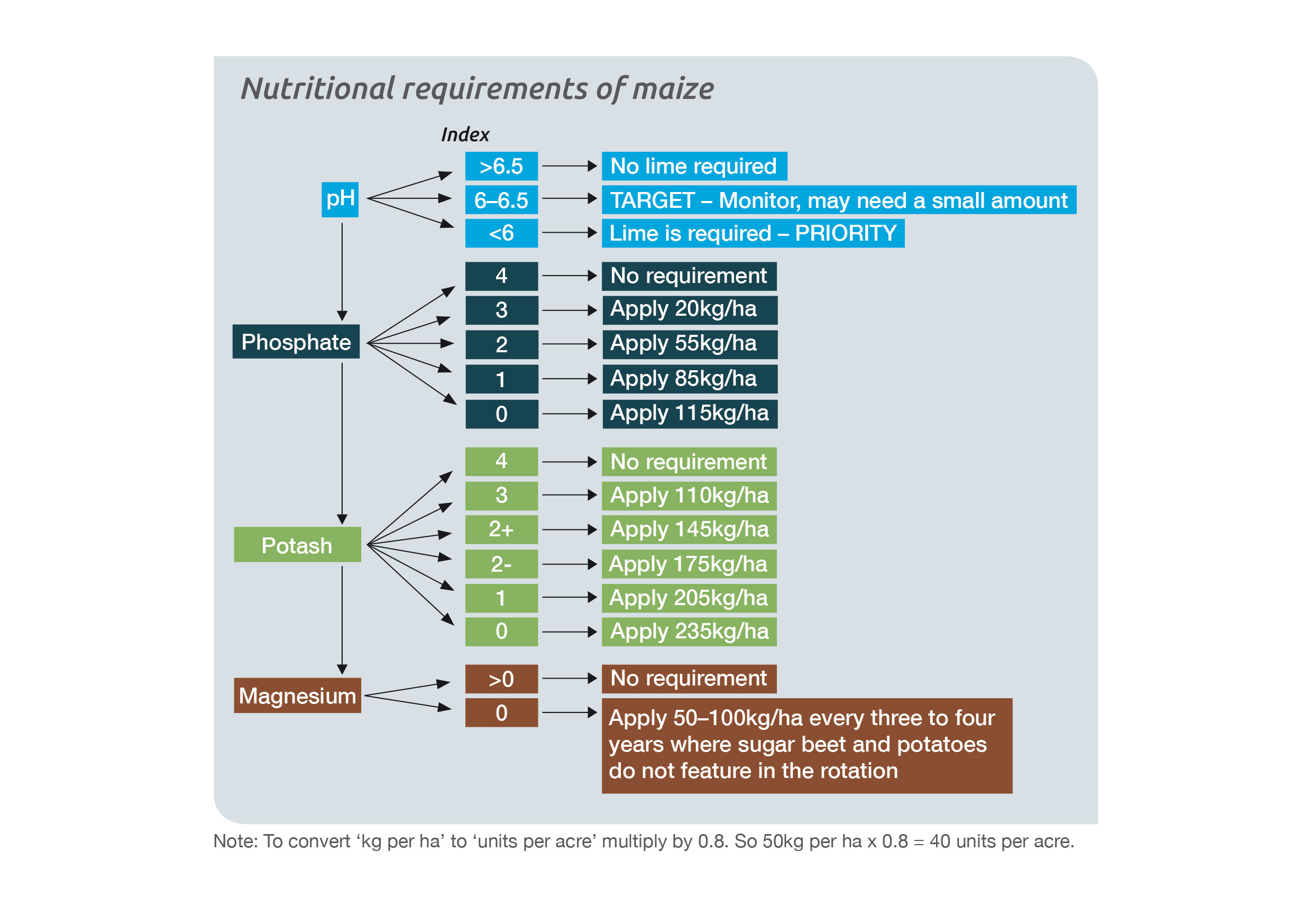- Home
- Knowledge library
- Maize crop nutrition
Maize crop nutrition
Find information on the nitrogen, phosphate and potash requirements of maize and avoiding nutrient overload.
Back to: Growing maize for silage
Nutritional requirements of maize
Figure 1. Nutritional requirements of maize

Maize has poor tolerance of acidic soils (<pH 5.0). Therefore, achieving the right pH is the first priority.
To encourage rapid growth, all phosphate and up to 10–15 kg/ha (8–12 units/acre) of the nitrogen (N) required can be placed below the seed at drilling. The remainder of the N can be top-dressed when the crop emerges. Potash should be applied before seedbed preparation and thoroughly worked in.
Applying organic manures when growing maize
Fields to be drilled with maize are suitable for organic manure applications – either farmyard manure or slurry.
To manage nutrients effectively, first, send relevant soil and manure samples to a laboratory for nutrient analysis. Use this information, along with crop requirement recommendations calculated from the Nutrient Management Guide (RB209), to determine the manure application rate and the amount of additional fertiliser needed. Time nutrient applications to coincide with crop growth to maximise uptake. Splitting recommendations into lower rates enables the soil to retain nutrients better.
Nitrogen requirement of maize
Soil nitrogen supply (SNS) cannot be easily measured, so fields are put into categories depending on their cropping history to estimate their likely requirement for N. Use the tables in the Nutrient Management Guide (RB209) to determine the SNS index of any field.
Where maize is grown continuously, N can build up in the soil, particularly where organic manures are spread regularly. Rotating with another crop, such as grass or potatoes, or planting an autumn crop after the maize has been harvested, can make the most of any residual N. Seek the advice of a FACTS-qualified adviser for detailed crop nutrition advice. Online tools such as 'Tried and Tested' are available to help develop a nutrient management plan.
Nitrate Vulnerable Zones (NVZs)
Effectively managing nutrients is important for all producers growing maize, but there are statutory limits for those within an NVZ. On these farms, the maximum limit (Nmax) for maize is 150 kg N/ha (120 units N/acre). The Nmax must account for all organic manures applied, and the amount of crop-available N present must be established.
From the end of the closed period to the end of February, no more than 30 m3/ha (12 m3/acre) of slurry or 8 t/ha (3 t/acre) of poultry manure can be applied in a single application, with at least three weeks between individual applications. Detailed guidance can be found at Nitrate vulnerable zones.
Closed periods for nutrient application
|
Nutrient |
Sandy or shallow soils |
Other soils |
|
Manufactured nitrogen |
1 Sept to 15 Jan |
1 Sept to 15 Jan |
|
Organic manures, high in readily available nitrogen, e.g. slurry or poultry manure |
1 Aug to 31 Dec |
1 Oct to 31 Jan |
Avoiding nutrient overload when growing maize
Nutrient application rates should be matched to crop requirements to avoid ‘nutrient overload’. Surplus nutrients can be lost to the environment via direct run-off into surface water or leaching into groundwater. Rapid incorporation of freshly spread manure will help make the most of the N content. Low emission spreading equipment, such as slurry injection, reduces ammonia losses.
MANNER-NPK is a free programme that can determine the nutrient availability of manures and their value for the following crop
The value of slurry to maize
|
|
Nitrogen (N) |
Phosphate (P) |
Potash (K) |
|
Maize requirement (kg/ha)a |
50 |
55 |
175 |
|
Total nutrients supplied by 30 m3/ha cattle slurry application (kg/ha) |
78 |
36 |
96 |
|
Crop-available nutrients (kg/ha)b |
29 |
18 |
86 |
|
Manufactured fertiliser required |
21 |
37 |
89 |
|
Slurry value in year onec |
£17 |
£22 |
£41 |
|
Total slurry value (per ha) |
|
|
£80 |
a Based on SNS Index 2, P Index 2 and K Index 2-
b Assuming 6% DM, not accounting for nutrient losses
c Assuming N = 90p/kg, P = 80p/kg, K = 60p/kg
Winter field management of maize
Maize fields can be a significant source of soil erosion. All maize fields must be actively managed to reduce the risk of soil, nutrient and agrochemical loss to the environment during winter.
Undersowing maize with a cover crop is an option for overwinter management, typically ryegrass or fescue. Broadcast or drill the cover crop into the growing maize around mid-June, which reduces the likelihood of it competing with the maize in the early stages. Typical grass seed rates are 5–15 kg per hectare (2–6 kg per acre). The cover crop will green up soon after harvest, using any surplus nutrients and reducing water and soil loss from the field. This is a useful way to establish grazing or cutting leys.
Sowing winter crops, such as winter wheat, after maize, may reduce the soil wash and erosion risk. Cultivating the field immediately after harvest can encourage water infiltration. Research has shown that cultivated fields absorb more water than those left unmanaged, so fewer nutrients, sediment and agrochemicals are lost.
Useful links
Download our guide to growing and feeding maize silage
Read the Nutrient Management Guides (RB209)
To order a hard copy of the Growing and feeding maize for better returns manual or the Nutrient management guides (RB209), please contact publications@ahdb.org.uk or call 0247 799 0069.
Topics:
Sectors:
Tags:

